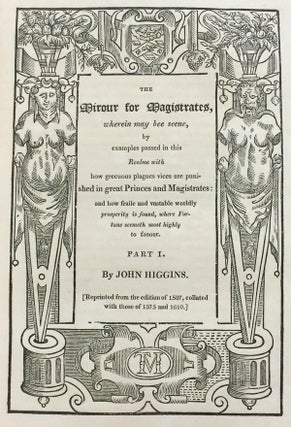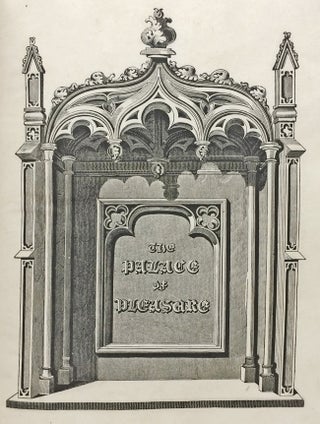Mirror for Magistrates (three volumes); WITH: The Palace of Pleasure (three volumes)
London: Printed for Lackington, Allen, and Co. Finsbury Square; and Longman, Hurst, Rees, Orme, and Brown, Paternoster Row; Reprinted for Robert Triphook, St. James's Street, by Harding and Wright, St. John's Square, 1815, 1813. Six quarto volumes, measuring 9.5 x 7 inches. Contemporary full brown crushed morocco gilt, gilt-ruled blindtooled boards, raised bands decorated in gilt, spine compartments decorated in blind, maroon endpapers, all edges gilt. Letterpress titles in Mirror for Magistrates printed in red and black, decorative engraved titles throughout all three volumes, small woodcut vignettes in Volume III; two engraved half-titles in Palace of Pleasure. Crease to front free endpaper of first volume of Mirror for Magistrates, lightest occasional foxing.
Deluxe large-paper reissues of two classic sixteenth-century source texts, the inspiration for some of the most important Elizabethan and Jacobean plays. Featuring chapters by a number of English poets, Mirror for Magistrates was at first suppressed by the Lord Chancellor in 1555, then published under Elizabeth in 1559, and expanded by new contributors over the decades to come. The anthology offers pointed verse portraits of historic rulers, good and bad, with an eye to instructing those in power; Philip Sidney, in his Defence of Poesy, recommends “Mirrour of Magistrates meetly furnished of beautiful parts." The chapter on “Queene Cordila" served as a key source for Shakespeare's King Lear: “I must assay your friendly faithes to prove: / My daughters, tell mee how you doe mee love." The Palace of Pleasure, first published in 1566 by William Painter, and expanded in subsequent editions, translates dozens of sensational tales from Continental sources, including the first English translations of Boccaccio's Decameron and Marguerite de Navarre's Heptameron. The anthology provided English playwrights with a rich supply of plots, inspiring The Rape of Lucrece, Titus Andronicus, Romeo and Juliet, All's Well That Ends Well, Timon of Athens, The Duchess of Malfi, Love's Cruelty, Insatiate Countess, and The Revenger's Tragedy. As the Cambridge History of English Literature observes: “it would be difficult to find a plot that has not had its origin, or its counterpart, in Painter’s treasure-house.” Sixteenth-century editions of Mirror for Magistrates and The Palace of Pleasure are exceptionally scarce. Editor Joseph Haslewood, a founder of the Roxburghe Club, strove to bring neglected Renaissance texts to the attention of nineteenth-century readers and collectors; these lavishly produced sets, issued in editions of 150 copies, were part of his mission. These volumes were splendidly bound by Charles Lewis, “the leading figure in English binding of the first years of the nineteenth century" (Maggs 1075). A fine collection of Shakespearean source material.
Price: $5,500.00





